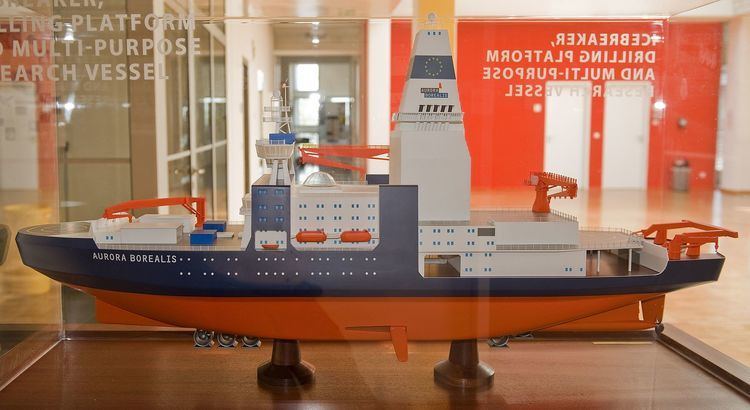Name Aurora Borealis Weight 66,040 tons Draft 13 m | Namesake Aurora Borealis Length 200 m Displacement 58.97 million kg Endurance 3 months | |
 | ||
Cost 800 M€<500 M€ (Aurora Slim) Beam 49 m (161 ft) (moulded)45 m (148 ft) (waterline) | ||
Aurora Borealis is a proposed European research icebreaker, comparable to the world's strongest icebreakers, planned jointly by a consortium of fifteen participant organizations and companies from ten European nations. If built, she would be the largest icebreaker ever built as well as the first icebreaker built to the highest Polar class, PC1.
Contents
The unique feature of the proposed vessel is its ability to perform scientific deep sea drilling in a sea ice covered ocean. The ship is proposed to have an operational lifetime of 35 to 40 years, with the main area of operations being the inner Arctic Ocean.
History and background
The planning for the vessel started in 2002. The project is coordinated by the European Polar Board, an expert board of the European Science Foundation.
In March 2007 the BMBF (the German Federal Ministry for Science and Education) funded the preparations for Aurora Borealis, the Helmholtz Association center Alfred Wegener Institute for Polar and Marine Research hosted this project.
In 2010, the German Council of Science and Humanities stopped to support the planning which made the future of the 800 million euro ship, designed by Schiffko (nowadays Wärtsilä Ship Design), uncertain. The project has been delayed, and a slightly smaller and cheaper (less than 500 million euro) version, Aurora Slim, has been suggested by the Finnish engineering company Aker Arctic.
Aurora Slim
The most prominent change from Aurora Borealis to Aurora Slim is that the insulated drilling rig is no longer present. The scientist have to rely on a mobile system and shallower boreholes of a few hundred meters instead of more than 1,000 metres (3,300 ft). She will also have only a single moon pool instead of two as in the original concept.
Like the original concept, the vessel is designed to break level ice up to 2.5 metres (8.2 ft) in thickness. However, the dynamical positioning system of the smaller vessel consists of three 15 MW azimuth thrusters and two 3.5 MW bow thrusters instead of three fixed propeller shafts with 27 MW propulsion motors and six 4.5 MW rectractable transverse thrusters. The number and output of generating sets has also been reduced.
Participants
The participants in the Aurora Borealis project are listed in the following table.
